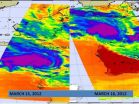In this release:
Measuring mercury in coastal fog water Early Eocene climate warming increased petroleum production Unexpected earthquakes within continental plates pose challenges Land use changes contribute to climate extremes When will warming-induced rainfall changes be perceptible? Model describes New Zealand's complex tectonic environment Geomagnetic data reveal unusual nature of recent solar minimum
Anyone may read the scientific abstract for any already-published paper by clicking on the link provided at the end of each Highlight. You can also read the abstract by going to http://www.agu.org/pubs/search_options.shtml and inserting into the search engine the full doi (digital object identifier), e.g. 10.1029/2011GL050324. The doi is found at the end of each Highlight below.
Journalists and public information officers (PIOs) at educational or scientific institutions who are registered with AGU also may download papers cited in this release by clicking on the links below. Instructions for members of the news media, PIOs, and the public for downloading or ordering the full text of any research paper summarized below are available at http://www.agu.org/news/press/papers.shtml.
1. Measuring mercury in coastal fog water
Mercury, a heavy metal neurotoxin, accumulates in sea life, in some cases
reaching levels that make seafood unsafe for humans to eat. How mercury gets
into aquatic organisms is debated, but part of the pathway could include mercury
carried in precipitation, including rain, snow, and fog. The contribution of
mercury in fog water in particular is not well known, especially in foggy coastal
areas such as coastal California. To learn more, Weiss-Penzias et al. measured
total mercury and monomethyl mercury concentrations in fog water and rainwater
samples taken from four locations around Monterey Bay, California, during
spring and summer 2011. They find that the mean monomethyl mercury
concentrations in their fog water samples are about 34 times higher than the mean
concentrations in their rainwater samples. Therefore, the authors believe that fog
is an important, and previously unrecognized, source of mercury to coastal
ecosystems. They also explored potential sources of mercury, finding that
biotically formed monomethyl mercury from oceanic upwelling may contribute to
monomethyl mercury in fog.
Source:
Geophysical Research Letters, doi:10.1029/2011GL050324, 2012
http://dx.doi.org/10.1029/2011GL050324
Title:
Total and monomethyl mercury in fog water from the central California coast
Authors:
Peter S. Weiss-Penzias, Cruz Ortiz Jr., and R. Paul Acosta: Department of
Microbiology and Environmental Toxicology, University of California, Santa
Cruz, California, USA;
Wesley Heim: Moss Landing Marine Laboratory, California State University,
Moss Landing, California, USA;
John P. Ryan: Monterey Bay Aquarium Research Institute, Moss Landing,
California, USA;
Daniel Fernandez: Division of Science and Environmental Policy, California State
University, Monterey Bay, Seaside, California, USA;
Jeffrey L. Collett Jr.: Department of Atmospheric Science, Colorado State
University, Fort Collins, Colorado, USA;
A. Russell Flegal: Department of Microbiology and Environmental Toxicology,
University of California, Santa Cruz, California, USA.
2. Early Eocene climate warming increased petroleum production
From the late Paleocene, about 58 million years ago, to the early Eocene, about 51
million years ago, Earth's surface temperatures warmed by about 5-10 degrees
Celsius (9 to 18 degrees Fahrenheit). Also in the early Eocene, there was an
increase of carbon-13-depleted carbon in the oceans that cannot be accounted for
by changes in carbon cycling at the surface. To better understand the source of
that carbon, Kroeger and Funnell modeled the thermal evolution of four
sedimentary basins in the southwestern Pacific Ocean. They show that the rising
surface temperatures of the early Eocene eventually led to warming of the
sedimentary beds deep beneath the surface. Petroleum can be produced at only a
certain range of temperatures; the rising temperatures at greater depths would
have brought more potential source rocks into temperature conditions under
which oil and gas can be produced and released. In fact, the researchers find that
the early Eocene warming would have led to the production and release of 50
percent more oil and gas than would have occurred under a constant temperature
scenario. Some of this newly produced oil and gas would not have been trapped in
sedimentary layers deep in the basin but would have leaked to the surface and
potentially reached the atmosphere, where it could have acted as a climate
feedback, causing further warming.
Source:
Geophysical Research Letters, doi:10.1029/2011GL050345, 2012
http://dx.doi.org/10.1029/2011GL050345
Title:
Warm Eocene climate enhanced petroleum generation from Cretaceous source
rocks: A potential climate feedback mechanism?
Authors:
K. F. Kroeger and R. H. Funnell: Institute of Geological and Nuclear Sciences,
Lower Hutt, New Zealand.
3. Unexpected earthquakes within continental plates pose challenges
Earthquakes that occur on "passive" continental margins, such as the August 2011
magnitude 5.8 Mineral, Virginia, earthquake, surprise people because they expect
earthquakes to occur only on plate boundaries. But, in fact, large and damaging
intraplate earthquakes occur fairly regularly on passive margins around the world.
For instance, in North America the approximately magnitude 7 Charleston
earthquake shook South Carolina in 1886, causing severe damage and about 60
deaths, and the 1929 magnitude 7.2 earthquake on the Grand Banks of
Newfoundland, Canada, caused a tsunami, a large landslide, and 28 fatalities.
Although they are fairly common, these earthquakes are not well studied, and
their specific geologic settings and causes are unclear. Wolin et al. review what is
known about these earthquakes and describe some of the challenges. They note
that these quakes, which occur both onshore and offshore, are thought to be
caused by reactivation of ancient faults created by previous continental collision
and breakup. Stresses causing passive margin earthquakes could be due to plate-
wide forces, glacial isostatic adjustment, local stresses, or other factors, but no
comprehensive model explains all of these earthquakes. Aftershocks of passive
margin earthquakes can occur for hundreds of years.
One challenge is that because large intraplate events occur infrequently and small
events are not well recorded, it has been difficult for scientists to collect enough
data on passive margin quakes to form a complete understanding. However, GPS
is making it possible to track tiny crustal deformations as small as one millimeter
per year (0.038 inches per year), so scientists can identify areas where strain is
building. The authors conclude that it is important to continue research on these
quakes, integrating seismic, geodetic, and geological techniques, to learn more
about the mechanisms causing passive margin earthquakes and to improve hazard
assessment.
Source:
Geophysical Research Letters, doi:10.1029/2011GL050310, 2012
http://dx.doi.org/10.1029/2011GL050310
Title:
Mineral, Virginia, earthquake illustrates seismicity of a passive-aggressive margin
Authors:
Emily Wolin and Seth Stein: Department of Earth and Planetary Sciences,
Northwestern University, Evanston, Illinois, USA;
Frank Pazzaglia and Anne Meltzer: Department of Earth and Environmental
Sciences, Lehigh University, Bethlehem, Pennsylvania, USA;
Alan Kafka: Weston Observatory, Department of Earth and Environmental
Sciences, Boston College, Weston, Massachusetts, USA;
Claudio Berti: Department of Earth and Environmental Sciences, Lehigh
University, Bethlehem, Pennsylvania, USA.
4. Land use changes contribute to climate extremes
Temperature extremes such as severe heat waves and cold spells are likely to
occur more frequently in a warming climate as carbon dioxide (CO2)
concentrations rise. But land use change, such as clearing forests for agriculture,
also has a large impact on extreme temperature events. To determine the relative
contribution of the two effects, Avila et al. ran simulations using a climate model
coupled to a sophisticated land surface model. They find that land use changes
can have a significant effect on temperature extreme indices. On regional scales,
land use changes in some cases amplified the effects of increased CO-
2 concentrations, while land use changes in other cases masked their effects. In
some regions, the effects of land use changes on temperature extremes were
similar in magnitude to those of doubling CO2. They conclude that land use
changes are a major source of human influence on the climate.
Source:
Journal of Geophysical Research-Atmospheres, doi:10.1029/2011JD016382,
2012
http://dx.doi.org/10.1029/2011JD016382
Title:
Climate model simulated changes in temperature extremes due to land cover
change
Authors:
F. B. Avila, A. J. Pitman, M. G. Donat, L. V. Alexander, and G. Abramowitz:
Climate Change Research Centre, University of New South Wales, Sydney, New
South Wales, Australia.
5. When will warming-induced rainfall changes be perceptible?
Global climate change is not only changing temperatures but also altering
precipitation. These changes in precipitation have been studied on large regional
levels, but studies have not been able to identify changes in observed precipitation
on smaller spatial scales. Natural interannual variability also makes it difficult to
perceive precipitation changes caused by global warming at a statistically
significant level. Using general circulation climate models to study future
precipitation changes, Mahlstein et al. estimated by how much global
temperatures would need to increase for the warming-induced precipitation
changes to be clearly noticeable on local or regional scales. They find that
temperatures would need to be 1.4 degrees Celsius (2.5 degrees Fahrenheit)
warmer than they were in the early twentieth century for regional precipitation
changes to be statistically significant. The authors note that this is likely to occur
by the end of this century.
Source:
Geophysical Research Letters, doi:10.1029/2011GL050738, 2012
http://dx.doi.org/10.1029/2011GL050738
Title:
Perceptible changes in regional precipitation in a future climate
Authors:
Irina Mahlstein, Robert W. Portmann, and John S. Daniel: Earth System Research
Laboratory, NOAA, Boulder, Colorado, USA;
Susan Solomon: Department of Atmospheric and Oceanic Sciences, University of
Colorado at Boulder, Boulder, Colorado, USA and Department of Earth,
Atmospheric and Planetary Sciences, Massachusetts Institute of Technology,
Cambridge, Massachusetts, USA;
Reto Knutti: Institute for Atmospheric and Climate Science, ETH Zurich,
Zurich, Switzerland.
6. Model describes New Zealand's complex tectonic environment
At the Hikurangi fault, off the eastern coast of New Zealand's North Island, the
Pacific tectonic plate sinks beneath the Australian plate. Farther south, in the
Marlborough Fault System, which cuts through the country's larger South Island,
the interaction between the two slabs turns such that the plates grind edge-on.
From north to south, over a relatively short length of the plate boundary, the
interaction switches from subduction to strike-slip. Though the fault systems near
each of New Zealand's major islands have been studied extensively, the
intervening region that harbors the transition between the two modes of
interaction is much less well understood. Exploring the subduction-to-strike-slip
transition region could help explain how and whether the fault systems that
populate the country are connected and potentially improve estimates of seismic
risk.
Seeking to fill out the picture of New Zealand's tectonic environment, Wallace et
al. modeled the independent fragments of the Earth's crust that make up the larger
plate boundary. Using measurements of known fault locations and stresses,
combined with recordings of ground velocity measurements drawn from 800 GPS
ground stations distributed across the country, the authors reverse engineered the
complex system of faults that crosses New Zealand. The authors find that the
switch from subduction in the north to strike-slip in the south is due to what they
describe as a kink in the Australian plate that cuts across the northern South
Island. They suggest that this deformation acts as a hinge about which the
northern part of the Pacific plate takes on a clockwise rotation. Further, the
authors' model allowed them to estimate the slip rate deficit for each fault, a
measure of the expected but as of yet unobserved plate motion that could indicate
an ongoing buildup of energy within the fault.
Source:
Journal of Geophysical Research-Solid Earth, doi:10.1029/2011JB008640, 2012
http://dx.doi.org/10.1029/2011JB008640
Title:
The kinematics of a transition from subduction to strike-slip: An example from
the central New Zealand plate boundary
Authors:
L. M. Wallace, J. Beavan, R. Van Dissen, N. Litchfield, R. Langridge, and N.
Pondard: GNS Science, Lower Hutt, New Zealand;
P. Barnes, J. Mountjoy, and G. Lamarche: National Institute of Water and
Atmospheric Research, Wellington, New Zealand.
7. Geomagnetic data reveal unusual nature of recent solar minimum
Since the mid-1800s, scientists have been systematically measuring changes in
the Earth's magnetic field and the occurrence of geomagnetic activity. Such long-
term investigation has uncovered a number of cyclical changes, including a signal
associated with 27-day solar rotation. This is most clearly seen during the
declining phase and minimum of each 11-year solar cycle, when the Sun's
magnetic dipole is sometimes tilted with respect to the Sun's rotational axis. With
the Sun's rotation and the emission of solar wind along field lines from either end
of the solar magnetic dipole, an outward propagating spiral-like pattern is formed
in the solar wind and the interplanetary magnetic field that can drive 27-day, and
occasionally 13.5-day, recurrent geomagnetic activity. Recurrent geomagnetic
activity can also be driven by isolated and semipersistent coronal holes, from
which concentrated streams of solar wind can be emitted.
During the most recent solar minimum, which took place from 2006 to 2010,
however, several researcher groups noticed 6.7-day and 9-day recurrent changes
in geomagnetic activity, and similar patterns in the interplanetary magnetic field,
and the solar wind. Using modern data covering the previous two solar minima,
these higher-frequency occurrences were judged to be unusual. Love et al.
analyzed historical geomagnetic activity records from 1868 to 2011 and find that
the 6.7-day and 9-day recurrent changes were actually unique in the past 140
years. They suggest that the higher-frequency changes in geomagnetic activity are
due to an unusual transient asymmetry in the solar dynamo, the turbulent, rotating
plasma deep within the sun which generates the magnetic field.
Source:
Geophysical Research Letters, doi:10.1029/2011GL050702, 2012
http://dx.doi.org/10.1029/2011GL050702
Title:
Geomagnetic detection of the sectorial solar magnetic field and the historical
peculiarity of minimum 23-24
Authors:
Jeffrey J. Love and E. Joshua Rigler: Geomagnetism Program, U.S. Geological
Survey, Denver, Colorado, USA;
Sarah E. Gibson: High Altitude Observatory, NCAR, Boulder, Colorado, USA.
###
END




